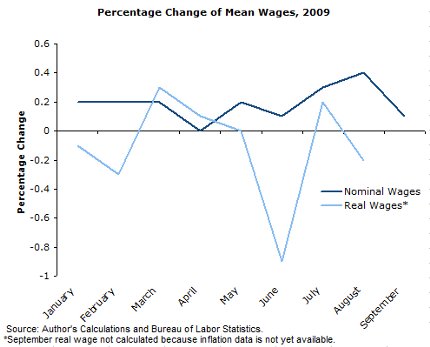The loss of 263,000 payroll jobs, coupled with a 0.1 hour decline in the average workweek, pushed the index of aggregate hours to 98.5, slightly below the 98.6 level in December of 1998. Hours worked have now declined by 8.6 percent from the pre-recession peak. In the 1981-82 recession the decline from peak to trough was 5.8 percent. The loss of jobs also pushed the unemployment rate to 9.8 percent. The unemployment rate for men hit 10.3 percent, surpassing the 10.1 percent peak in the 1981-82 recession.
The accelerated pace of job loss was driven primarily by the government, retail, and educational services sectors. The government sector lost 53,000 jobs in September, compared with a loss of 19,000 jobs in August. Most of the job loss was again at the state and local level, which together accounted for 47,000 of the lost jobs. The private educational services sector, which had been adding jobs through the recession, lost 16,900 jobs in September. These job losses, like the state and local cutbacks, are largely the result of budget shortfalls since much of the funding for these services comes from the public sector. Retail trade lost 38,500 jobs in September after losing just 8,800 in August. The biggest difference here was in the auto sector — 7,100 jobs lost, after having added 3,500 in August to meet demand from the Cash for Clunkers program.
The construction sector continued its rapid pace of job loss, shedding 64,000 jobs in September, mostly in non-residential construction. Manufacturing lost another 51,000 jobs. The loss of jobs, coupled with shorter workweeks, has led to a fall in the index of aggregate hours worked in manufacturing of 22.0 percent from its pre-recession peak in July of 2006. Hours worked in this sector have dropped 39.1 percent since December of 1997.
Wage growth continues to weaken with wages rising at just a 1.7 percent nominal rate over the last quarter, almost certainly less than the rate of inflation.
This month, the Bureau of Labor Statistics (BLS) reported its preliminary benchmark revisions to the establishment survey data. This revision, based on unemployment insurance records, shows that employment in March of 2009 was 824,000 lower than originally reported, with private sector employment 855,000 lower. This extraordinarily large downward revision is not surprising because the imputation for new firms not included in the survey was consistently larger than the imputation from the prior year when the economy was still growing. Including this revision, the economy has lost over eight million jobs in the downturn.
The 0.1 percentage point rise in the unemployment rate was coupled with a 0.4 percentage point drop in the employment rate, as there was a sharp decline reported in the size of the workforce. The employment to population ratio (EPOP) is now 4.6 percentage points below its pre-recession peak and 5.9 percentage points below the peak reached in 2000. Unemployment continues to disproportionately hit men, with the unemployment rate for women a relatively low 7.8 percent. However, with job losses in manufacturing slowing and job losses in the government sector rising, women will be harder hit in coming months. Black women have been especially hard hit. At 55.0 percent, the EPOP for black women in the last two months has fallen below the EPOP for white women (55.8 percent) for the first time ever.
By education group, high school graduates took the biggest hit in September, with a 1.1 percentage point rise in their unemployment rate to 10.8 percent. However, even the 4.9 percent unemployment rate for college graduates is higher than the overall unemployment rate before the recession. All the duration measures of unemployment rose in September, with the 26.2-week mean duration setting a new record as did the 35.6 percent share of long-term unemployed.
The data in this report indicates that a turnaround in the labor market is not imminent. Continuing losses of jobs and declines in hours, coupled with stagnant or declining real wages, means that workers’ purchasing power is still falling. There are no further tax breaks scheduled to boost demand and state and local governments are cutting back and raising taxes to address budget shortfalls. The immediate future does not look good.
Dean Baker is Co-Director of the Center for Economic and Policy Research, in Washington, D.C. This article was first published by CEPR on 2 October 2009 under a Creative Commons license. This year is the tenth anniversary of CEPR. To donate to CEPR so it can continue its good work, click here.

